| ・糸巻 Itomaki |
・棹 Sao |
・胴、皮 Doh, Kawa |
・駒 Koma |
・糸 Ito |
・指掛け Yubikake |
・撥 Bachi |
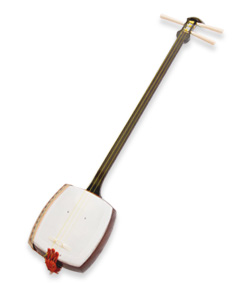
16世紀、信長、秀吉の時代に、中国から琉球を経て大坂の堺にもたらされ、さまざまな改造がなされて江戸時代には広く人々に普及しました。左手の指で棹上の糸を押さえ、右手に持った撥で糸を弾きます。棹にはギターのようにフレットがないので、押さえる場所(勘所)は訓練により体得します。撥(ばち)は琵琶の撥(ばち)を改良したものといわれています。一挺、二挺・・・と数えます。
Shamisen came to Sakai in Osaka from China via Ryukyu in the Nobunaga and Hideyoshi eras in the 16th century. It was remodeled in various ways and popularized in the Edo era. We play the string with a plectrum ‘Bachi’ in our right hand, pressing the string on a pole called ‘Sao’ with the fingers of our left hand. There are no frets different from guitars, so the pressing position can only be mastered through training. Bachi is believed to be remodeled from Bachi of biwa. It is counted as one cho, two cho ……..
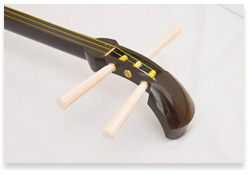
弦の一端を巻きこみ張力を与え、固定して弦の音の高さを定める部分です。” 調弦を変えるとき”や” 演奏中に音が変わってしまって調整するとき ”などにこの部分を動かします。材質は象牙や、木のものもあり、色や大きさ、形状はジャンルによって異なります。
Itomaki is a part to the tone of the string, and this tension is set by winding one end of the string and fixing it. This part can be operated when we tune the string section and when we adjust the tone in playing etc. It is made of ivory or wood. Color, size and figure are different in genre.
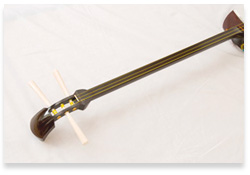
演奏する際、弦が押さえられる部分です。文楽の義太夫節で用いられる「太棹」、地歌や清元節などで用いられる「中棹」、長唄、端唄、山田流箏曲などで用いられる「細棹」と分けられます。ただし、棹の太さは演奏者などによって異なり、それぞれ太さが定められているわけではありません。材質はインド産の紅木(こうき)という、堅く重い素材などを用います。
Sao is a part to press the string. It is divided into a thick pole called `Futozao` used in Gidayubushi of Bunraku, a middle pole called `Chuzao` used in Jiuta and Kiyomotobushi etc, and a thin pole called `Hosozao` used in Nagauta, Hauta, Yamada Kato etc. However, as the thickness of Sao is not defined, it varies among the players. It is made of the hard and heavy material such as Redsander wood in India.
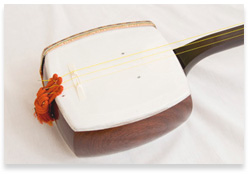
胴はやや湾曲した4枚の板を張り合わせた枠状になっており、材質は花梨(かりん)などを用います。
その両面に猫または犬の皮を張ります。胴の大きさ、皮の厚さなどはジャンルや演奏者によって異なります。演奏の際、棹の付け根に近い所で撥(ばち)が皮に当たるが、ここに撥皮という小さく薄い皮を張ります。
Doh is like a frame in which 4 slightly bent boards are put together and the material could be quince etc. The skin of a cat or a dog is drawn tight on the both sides. The size of Doh and the thickness of the skin are different in genre and players. In playing as a plectrum strikes the part close to the foot of a pole, a little thin skin called Bachigawa is drawn tight.
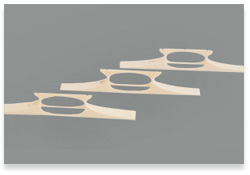
糸の振動を胴に伝えるためのもので、糸を上にのせます。材質、形状、大きさはジャンルなどによってさまざまです。材質は象牙が多く用いられていますが、一部では水牛の角なども用いられます。ジャンルによっては鉛を埋め込むこともあります。
Koma conveys the vibration of the string to Doh and the strings are put on it. The material, figure and the size vary in genre. Ivory is usually used as the material, but the horn of water buffalo is also used in a part. Lead is implanted in some genre.
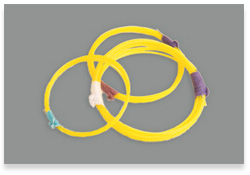
三味線では弦を「糸」と言います。演奏者が構えているところを正面から見て、上から一の糸、二の糸、三の糸といいます。一の糸が一番低く調弦され、二の糸、三の糸と高くなっていきます。材質は絹ですが、テトロンなど化学繊維のものもあります。
A string is called `Ito` in shamisen. Looking at the front of the player holding shamisen, it is called the first string, the second string and the third string from the top. The first string is tuned the lowest and the third one is the highest. The material is mainly silk but sometimes chemical fibers such as Dacron are used.
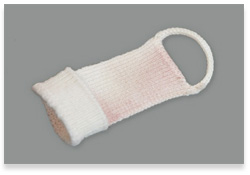
左手の親指と人差し指に掛ける、布製のもの。棹を左手が移動する際に、棹との摩擦で邪魔されないよう、滑らかにする役割のものです。
Yubikake is made of cloth and it is bridged between the thumb and index finger of the left hand. It decreases the friction between the pole and left hand, allowing the left hand to move smoothly on the pole.
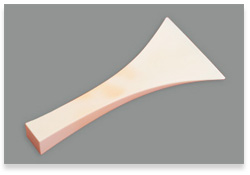
弦を弾くためのもので、大きさ、撥先の厚さや撥先への広がり方はジャンルや演奏者によって異なります。使い込んでいくと撥先が減ってくるので、メンテナンスが必要です。材質は象牙製が基本。ジャンルによっては撥先にべっ甲を用いることもあります。
Bachi is used to pluck the string. The size, thickness of the top and the extent toward the top of Bachi all depend on the genre and players. Bachi needs maintenance, because the top part wears out as it is used. It is usually made of ivory, but sometimes tortoise shell is used on the top of it in some genre.
| ・歌口 Utaguchi |
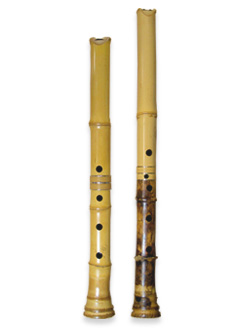
竹製の縦笛。正倉院などにも収められている古いものもありますが、主として江戸時代に禅宗の一派である普化宗(ふけしゅう)の修養のための楽器として用いられました。真竹(まだけ)の根元部分を用い、内側の節は削られ、漆(うるし)が塗られています。長さは一尺八寸が標準ですが、さまざまな長さのものがあります。指孔は、全面に4つ、背面に1つ。指の動きや息遣いの細かい技巧や、あごの上げ下げなどで音色や音高の微妙な調節ができます。
Shakuhachi is a vertical flute made of bamboo. It was mainly used as an instrument for discipline of Fukeshi Buddhism which was one group of Zen Buddhism in the Edo era. It is made of a bamboo stem near the root, with the joints inside shaved and painted with Japanese lacquer. The standard length is about 54.5 centimeters, but there are some in various lengths. It has four finger holes in front and one at the back. Through various combinations of fingering and blowing techniques, it can produce a plaintive and fascinating sound.
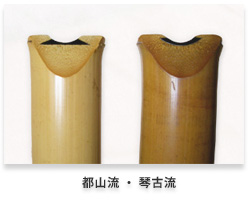
息を吹き付ける場所。尺八の上端にあり、外側に向かい斜めに削り落とされています。水牛の角または象牙などを細工したものをはめ込みますが、この形は流派によって異なります。
Utaguchi is a part to blow. It is at the top of Shakuhachi and is shaved down toward the outside diagonally. The horn of the water buffalo or the ivory is fitted into utaguchi and the figure depends on schools.
| ・胴 Doh |
・柱 Ji |
・爪 Tsume |
・弦 Gen |
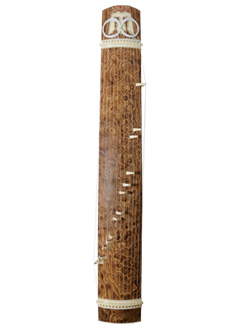
奈良時代に中国から伝わった楽器で、13本の弦が張ってあります。「爪」と呼ばれるピックのようなものを右手にはめ、はじいて弾きます。はじき方や左手の使い方にもさまざまな技巧があり、多彩な音色が出せます。現在は、大きく分けて生田流と山田流という流派があります。生田流は先が四角い角爪を用い、この角を有効に使うため楽器に対し左斜め約45度に構えますが、山田流は先が丸みを帯びた丸爪を用い正面に構えます。箏は一面、二面・・・と数えます。
Koto is an instrument which came from China during the Nara era and it has 13 strings, each stretching over a bridge which are plucked with something like picks called `Tsume` attached to the fingers of the right hand. There are various techniques used in plucking and how to use the left hand, and various tones can be produced. At present, broadly speaking, there are two schools - Ikuta school and Yamada school. Ikuta school uses corner Kaku-Tsume which has a square tip. In order to make use of this corner, players sit at about 45 degree to the left toward the instrument. On the other hand, players in Yamada school sit while facing the instrument because of the use of a Maru-Tsume with a round tip. It is counted like one men, two men , …… .
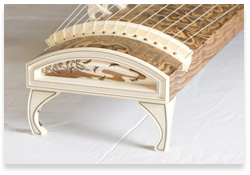
用いられるジャンルによって大きさは異なりますが、地歌・箏曲では長さが約180cm、幅は約24cm、厚さは約7cm程度。箏を竜の体にたとえ、両端部を「竜頭(りゅうとう)」「竜尾(りゅうび)」といい、多くの場合、そこに装飾が凝らされています。材質は桐(きり)で、最低でも20年以上、名器には200年以上の樹齢を必要とします。
The size depends on the genre. It has dimensions of about 180 centimeters long, 24 centimeters wide, and 7 centimeters thick for Jiuta and Koto music. Koto is likened to the body of a dragon and both ends are called ‘dragon’s head` and ‘dragon’s tail`. In most cases, ornaments are put on them. It is made of paulownia wood which is at least over 20 years old and over 200 years old in masterpieces.
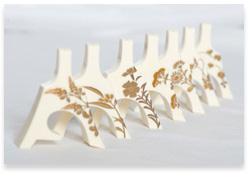
各弦に1つずつの柱を立て、音の高さを定める部品。演奏中に音が狂ってしまったとき、調弦を変えるときに、その位置を左手で素早く動かして音を調節します。一番手前の弦の柱は他の12個の柱とは形状が異なり、胴の上面と側面とで固定できるようになっています。材質は象牙が基本、大きさは流派などによって異なります。中には装飾を施したものもあります。
Ji is a part to fix the tone, by putting one Ji on each string respectively. We adjust the tone by moving the position quickly with our left hand when the string gets out of tune while playing or when we tune the string section. The figure of ji of the string on this side is different from the ones of other 12 Ji and it can be fixed on the top and the side of Doh. It is basically made of ivory and the size depends on schools etc. Some have ornaments.
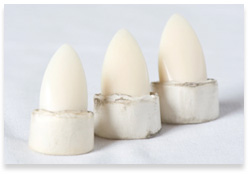
右手の親指、人差指、中指には爪をはめます。弾く際に弦と接する部分の材質は象牙を用います。指にはめる部分は革、布、紙などで作られています。爪を入れる小箱には、演奏者の好みによってさまざまなデザインがほどこされています。
Tsume are attached to the thumb, the forefinger and the middle finger of the right hand. The part exposed to the strings while playing is made of ivory. The part to put on the finger is made of leather, cloth and paper etc. The small box for keeping ‘Tsume’ comes in various designs according to the taste of the player.
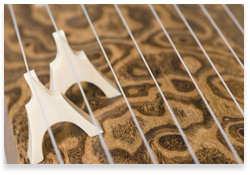
材質は絹ですが、近年ではナイロンやテトロンなどの化学繊維製のものが主流です。演奏者からみて、遠い方から「一、二、三、・・・十、斗(と)、為(い)、巾(きん)」という名称がついています。弦の太さは箏の種類、流派、演奏者によって異なります。
It is made of silk, but nowadays mainly from chemical fibers like nylon, dacron, etc. From the far-off string from the player, it is called `one, two, three,・・・,ten, to, i, kin`. The thickness of the string is decided by the type of Koto, school, or player.
| ・革、調べ、胴 Kawa, Shirabe, Doh |
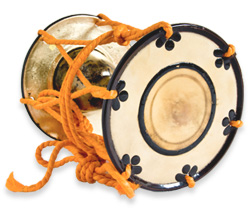
能、歌舞伎や民俗芸能で用いられます。胴、革(馬の革)、調べと3つに分けられます。右肩の上にのせ、左手は肘を張り、すべての指で調べを握り、右腕を下方から自然に曲げるようにして革を打ちます。リズム楽器として鋭さを保ちながらも、柔らかさも同時に感じさせるなど、響きは繊細です。
Ko-tsuzumi is used in Noh, Kabuki and folk performance. It is divided into 3 parts as well as O-tsuzumi and Taiko: a body called Doh, leather (a horse-skin leather) called Kawa and a string called Shirabe. It is held on the player’s right shoulder and hit with fingers of the right hand bending from down naturally as bending the elbow of the left hand and grasping Shirabe with all fingers. It produces the softness as well as sharpness as a rhythm instrument. The echo is very delicate.
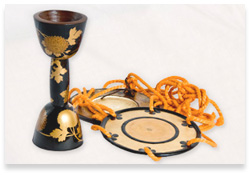
革を胴に固定するための、麻でできた紐が調べです。演奏の際は、調べを握る左手の強さと、革のどこを打つかによって音色が変わります。革にとって乾燥は大敵で、演奏中には息を吹きかけるなどして湿気を保ち、裏革に小さく切った和紙を調子紙として貼り、音のバランスを保ちます。胴の表面には蒔絵(まきえ)が施されています。
A string made of hemp to fix Kawa (leather) to Doh(a body) is Shirabe. In playing, the tone depends on the strength of the left hand grasping Shirabe and where to hit Kawa. As dryness is an enemy of Kawa, the balance of the sound is kept by keeping it wet and by blowing while playing and also by sticking small cut Japanese papers to the back of Kawa.
| ・革、調べ、胴 Kawa, Shirabe, Doh |
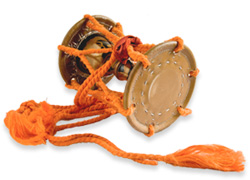
能、歌舞伎や民俗芸能で用いられます。小鼓と同様の形で、胴(桜)、革(牛の革)、調べと3つからできていますが、サイズは一回り大きく、「おおかわ」とも通称されます。大鼓は、小鼓のように肩にかつがず、左ひざの上に置き、左手で調べを握って、右手の中指と人差指につけた指皮で、打ち下ろすように革を打ちます。
O-tsuzumi is used in Noh, Kabuki and folk performance. It is made of 3 parts, Doh (cherry tree), Kawa (a cow-skin leather) and Shirabe( a string) and the same shapes as Ko-tsuzumi. The size is much bigger and it is sometimes called ‘Ohkawa’. O-tuzumi is not held on the player’s shoulder unlike Ko-tsuzumi. It is placed on the left knee. Kawa is stricken like hitting down by the finger leather attached to the middle finger and an index finger of the right hand, grasping Shirabe (strings) with the left hand.
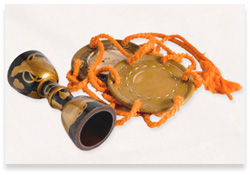
革は牛を用い、堅く、乾いた鋭い音を出すために湿気を嫌い、演奏前に革を火鉢(電熱器)であぶって極端に乾燥させるのが、小鼓と大きく異なる点です。そのため、革は4、5回使えば音色が変化して使えなくなってしまいます。また、小鼓は素手で革を打ちますが、大鼓の場合は、和紙を固めて作った指皮を着けて革を打つ点も異なります。
Kawa is made of a cow skin and is dried up extremely by warming in hibachi (a charcoal brazier) before performance as it dislike wetness to produce hard, dry and sharp sound, which is a big difference from Ko-tsuzumi. Therefore Kawa is worn out because the tone changes after 4-5 times of usage. And, Kawa is struck with bare hands in Ko-tsuzumi’s case, but in O-tsuzumi’s case, it is struck by finger leather made of hard Japanese paper.
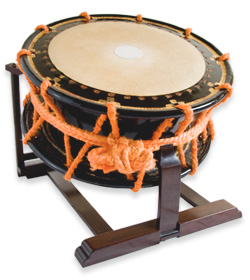
邦楽の囃子で標準的に用いられる太鼓のタイプは、とくに「締太鼓(しめだいこ)」と呼ばれます。胴、革、調べという構造は小鼓、大鼓と同じ。胴の材質は欅(けやき)で、小鼓や大鼓よりも直径が大きく、対して幅は著しく狭くなっています。革は牛革で、表革の中央に撥革といわれる直径4cm程の鹿革を貼ります。麻の調べで強く締め上げるように胴に固定し、その締め具合で音程を調整します。樫(かし)や紫檀(したん)などの固い木で作られている専用の台に乗せ、2本1組の檜(ひのき)製の撥で打ち下ろすように演奏します。
The type of Taiko which is usually used as an instrumental music of Japanese music is called Shimetaiko. The structure of Doh, Kawa and Shirabe is the same as Ko-tsuzumi and O-tsuzumi. Doh is made of zelkova tree. The diameter is longer than Ko-tsuzumi and O-tsuzumi, but the width is extremely narrow. Kawa is a cow skin and about 4 centimeters diameter size of deer skin called Bachi kawa is stuck in the middle of the front skin. Shirabe made of hemp is fixed in order to fasten it strongly and the tone is adjusted by fastening. It is placed on a special stand made of any hard tree such as an oak tree or rosewood and played by striking with a pair of plectrums made of cypress called ‘Bachi.’
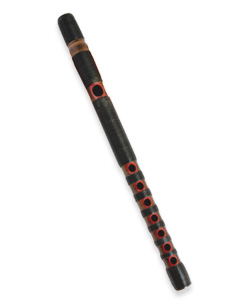
能や歌舞伎などで用いられる横笛。細い竹から作ります。内側を漆(うるし)で塗ったり、表側には籐(とう)や樺(かば)を巻き付けたり、あるいは内部には短い管を入れるなど、細かい構造となっています。指孔は7つ。唄や三味線とは不協和音になりもする直線的な響きから、柔らかな音色まで幅広い表現が可能です。指の使い方(孔の押さえ方)、唇の当て方などで音色の変化をつけられます。
Nohkan is a horizontal flute used in Noh and Kabuki. It has seven finger holes and is constructed from strips of bamboo. It has a delicate structure such as painting Japanese lacquer inside, winding a cane or a birch tree on the front or putting a short pipe inside. It can produce a wide expression from the linear echo which is apt to be a discord with a song and Shamisen to soft tone. The tone is changed by using the fingers (how the holes are pressed), how to touch the lip and so on.
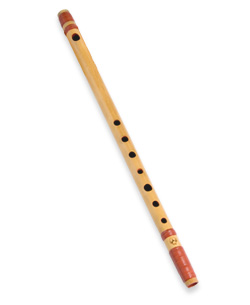
歌舞伎や民俗芸能、全国各地の祭囃子などで用いられる横笛。能管同様、細い竹から作るが、異なるのは竹そのものの生地を活かすという点です。指孔は7つが基本です。(民俗芸能には6つのものも、5つ以下のものもある。)長さが異なる何本かの管を持ち替えて、さまざまな調に対応します。能管と比べて構造は単純ですが、繊細でまろやかな旋律を奏でることができます。
Shinobue is a horizontal flute used in Kabuki, folk performance and festivals in all parts of the country. It is constructed from strips of bamboo as well as a Noh flute called Nohkan, but the difference is to make use of the bamboo itself. Basically it has 7 finger holes. There is Shinobue with 6 holes or less than 5 holes in folk performance. By changing many pipes whose lengths are different, it produces various tones. Compared to Nohkan, the structure is simple, but it produces delicate and mild melody.



